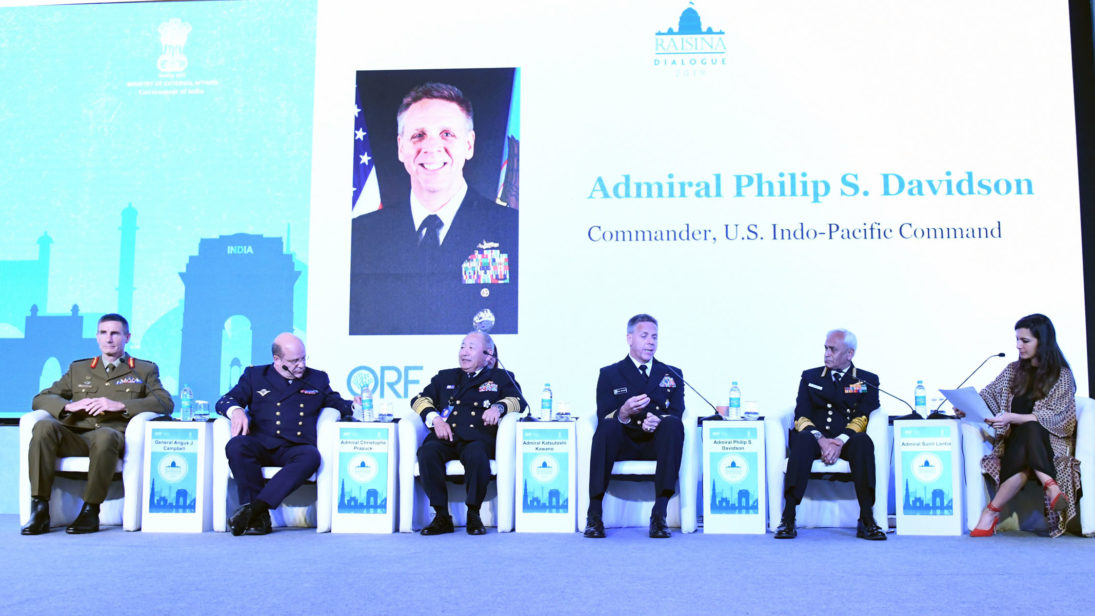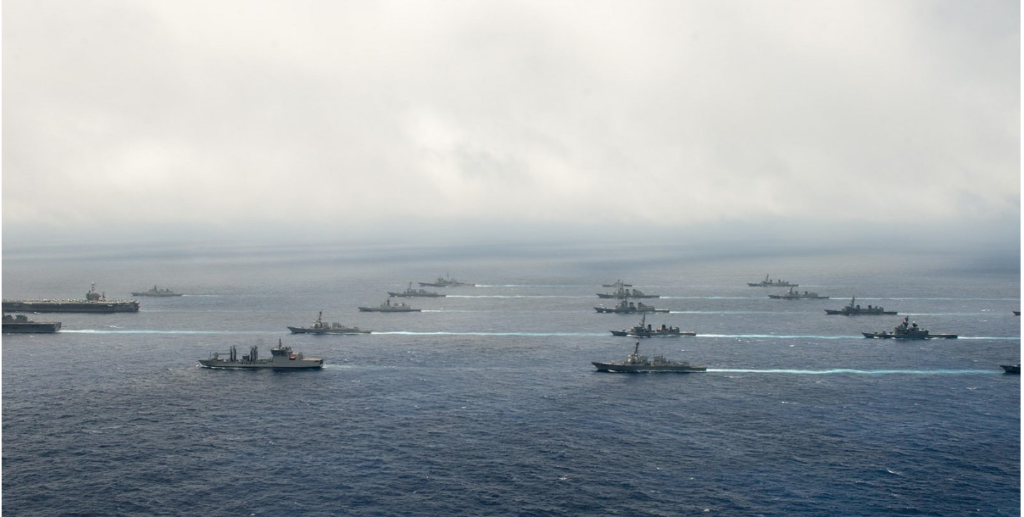
At the Raisina Dialogue, an annual multilateral conference on geopolitics and geoeconomics hosted by the Indian Ministry of External Affairs and Observer Research Foundation in New Delhi recently, military leaders of the Quadrilateral Security Initiative (Quad) countries (Australia, Japan, India, and the United States) and France participated in a panel titled “Indo-Pacific: Ancient Waters and Emerging Geometries.” At this panel, responding to a question on the nature of the Quad, the Indian Navy Chief, Sunil Lanba, was categorical in pointing out that the Quad doesn’t represent any military aspect at the moment. There are three strands of thought that could be picked up from his remarks. First, what is the real significance of the Quad grouping in India’s Indo-Pacific strategy at the moment? Second, how is it likely to change in the future? And finally, would there be a declared military component to the Quad at some point? The Chief of the Japanese Self Defense Forces was the only leader to voice the China threat. Australia and the United States neither confirmed nor out right denied future consideration of a military aspect to the Quad. And India was the only one to categorically deny any military role for the Quad. This says a lot about clarity and consensus, rather the lack of it, regarding the Quad’s agenda.
Admiral Lanba’s comments suggest that for India, the Quad currently stands for nothing more than a multilateral forum that seeks an international rules-based order, but little is said or known about how that order will come about. For instance, asserting that a free, open, inclusive, and rules-based international system is the core essence of the Quad, Admiral Lanba cited that India has not only honored international rules and agreements but also the judgement of the International Court of Justice (ICJ) regarding a maritime boundary dispute between India and Bangladesh. This was clearly a jibe at China and its blatant disregard of the 2016 ICJ ruling in favor of the Philippines. Lanba added that this honoring of international code is what the Quad represents. But it seems that India’s expectations of the Quad honoring this code stops short of any enforcement of this code, which seems unsustainable in the face of realist interpretations of the current world order where anarchy looms large.
Bridging the Quad & the Indo-Pacific: Need of the Hour
India’s dilemma about the Quad has a lot to do with China but it’s not just that. India’s reluctance to be seen as part of any containment strategy directed at China has emerged primarily from the apprehension that China could complicate both regional and international matters for India. This has led to a persistent decoupling of the Quad from the Indo-Pacific strategy, whether it is by direct measures such as India specifically clarifying that it does not consider the Quad to be a part of its Indo-Pacific policy or through indirect measures such as repeatedly excluding Australia from the Malabar naval exercises comprising India, the United States, and Japan.
The constant attempt by India to decouple the Quad from the narrative of the “free and open Indo-Pacific” further dilutes its strategy in the region. Initially, New Delhi gave the impression that this decoupling would allow it to be in a unique position in the Indo-Pacific, where it could play both sides. However, it is increasingly clear that India’s neutrality is being seen as its weakness by some analysts. Even the other members of the Quad are not keen on immediate militarization of the grouping. But unlike India, a combined show of strength through joint patrols of the maritime area extending from the Gulf to the South China Sea has been on the top of the agenda of other members of the Quad. The United States has led the way by conducting 20 Freedom of Navigation Operations (FONOPS) targeting 10 Asian nations in 2017 alone. Moreover, unlike India, other members of the Quad are deploying naval assets to the region to support U.S. actions. While the United States and Japan’s combined exercises in the South China Sea are routine, Australia’s inhibitions seems to be going away.

The primary point of difference between India and other members of the Quad is that it places a higher premium on inclusiveness in its Indo-Pacific policy than the others–it ambitiously seeks to have a robust regional strategy involving the United States and others to balance against China while also partnering with Beijing and Moscow, wherever possible, in the region. However, it would behoove New Delhi to remember that it was due to the very actions of the Chinese, such as their increasing presence and assertiveness in the Indian Ocean, that India joined the Quad in the first place.
India continues to draw a distinction between its Indian Ocean-centric regional vision and the Pacific-centered view of the other members of the Quad, as highlighted by some scholars. But India should start seeing the Quad and the Indo-Pacific as symbiotic and not distinct because their objectives are the same—finding ways to cope with the changes that China’s rise brings, irrespective of which theater it is in. At Raisina, Admiral Davidson, the U.S. INDOPACOM commander, suggested that the Quad countries help ASEAN nations in their discussion with China on a Code of Conduct in the South China Sea. This could be one way for India to bridge its Quad-related activities with its Indo-Pacific strategy, especially since New Delhi has emphasized its Act East Policy as the cornerstone of its engagement in the Indo-Pacific region. Another way would be to establish a working partnership with the Australia-Japan-United States trilateral forum while continuing to strengthen the trilaterals with Quad members that it is already a part of, such as Japan, United States, and India (JAI) as well as Australia, Japan, and India. This could allow India to expand the Quad countries’ goals for the Indian Ocean region while also gaining an understanding and appreciation of their objectives in the Pacific.
Conclusion
India should seriously assess the pros and cons of remaining the only neutral party in the Quad, especially when it comes to China. The only perceived benefit for India from such a position is that it can potentially hedge against both sides and get concessions in the process. However, as flux in geopolitics would suggest, India might not have the opportunities available through a bolstered Quad in the future should international alignments change. India prioritizes the resolution of its border dispute with China over a grand regional strategy with potential anti-China implications. But New Delhi is probably missing the point that border talks from a position of strength would always be more effective than an overtly cautious foreign policy outlook. A well-knit Quad unit would be one of the ways to secure a vantage point vis-à-vis China in either New Delhi’s border talks or its opposition to the Chinese BRI that maps the entire Indo-Pacific. Thus, India should move constructively to make the Quad the “anchor” of its Indo-Pacific strategy.
***
Image 1: MEAphotogallery via Flickr
Image 2: U.S. Pacific Fleet via Flickr (cropped)


